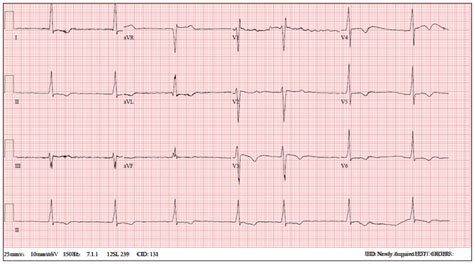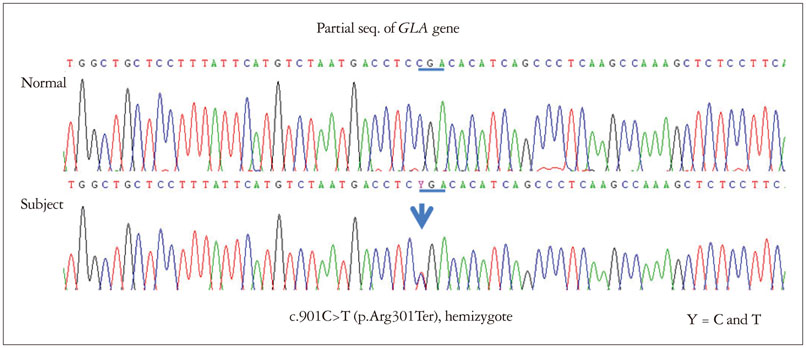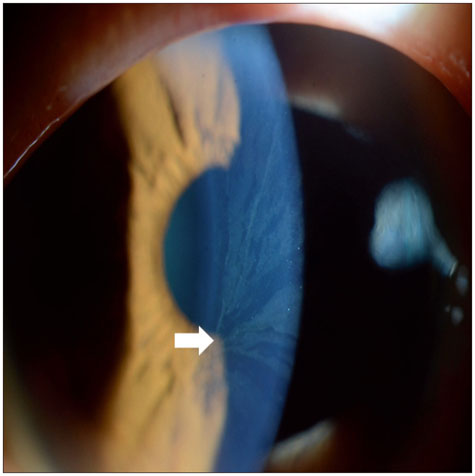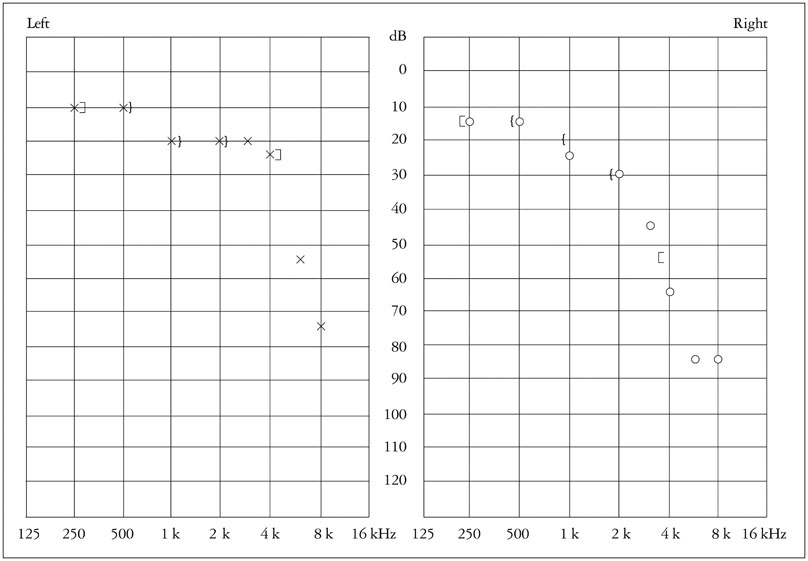J Cardiovasc Ultrasound.
2016 Dec;24(4):324-328. 10.4250/jcu.2016.24.4.324.
Fabry Disease Presenting with Hypertrophic Cardiomyopathy and Tricuspid Regurgitation
- Affiliations
-
- 1Department of Cardiology, Asan Medical Center, University of Ulsan College of Medicine, Seoul, Korea. jmsong@amc.seoul.kr
- 2Department of Pediatrics, Medical Genetics Clinic and Laboratory, Asan Medical Center, University of Ulsan College of Medicine, Seoul, Korea.
- 3Department of Cardiovascular Surgery, Asan Medical Center, University of Ulsan College of Medicine, Seoul, Korea.
- KMID: 2364651
- DOI: http://doi.org/10.4250/jcu.2016.24.4.324
Abstract
- A 71-year-old female who was diagnosed with nonobstructive hypertrophic cardiomyopathy since 1999 presented with dyspnea and severe edema on both legs. For the management of her symptom, cardiac surgery including tricuspid annuloplasty, Maze operation and right atrial reduction plasty was performed. During follow-up after cardiac surgery, a plasma α-galactosidase activity was checked for the screening of Fabry disease and the result was around lower normal limit. DNA analysis was implemented for confirmation and it revealed a heterozygote α-galactosidase mutation at exon 6 [c.901C>T (p.Arg301Ter)]. This case suggests that Fabry disease might be easily undetected, and clinical suspicion is critical.
MeSH Terms
Figure
Reference
-
1. Schiffmann R, Kopp JB, Austin HA 3rd, Sabnis S, Moore DF, Weibel T, Balow JE, Brady RO. Enzyme replacement therapy in Fabry disease: a randomized controlled trial. JAMA. 2001; 285:2743–2749.2. Nakao S, Takenaka T, Maeda M, Kodama C, Tanaka A, Tahara M, Yoshida A, Kuriyama M, Hayashibe H, Sakuraba H, Tanaka H. An atypical variant of Fabry's disease in men with left ventricular hypertrophy. N Engl J Med. 1995; 333:288–293.3. Chimenti C, Pieroni M, Morgante E, Antuzzi D, Russo A, Russo MA, Maseri A, Frustaci A. Prevalence of Fabry disease in female patients with late-onset hypertrophic cardiomyopathy. Circulation. 2004; 110:1047–1053.4. Kampmann C, Baehner F, Whybra C, Martin C, Wiethoff CM, Ries M, Gal A, Beck M. Cardiac manifestations of Anderson-Fabry disease in heterozygous females. J Am Coll Cardiol. 2002; 40:1668–1674.5. Desnick RJ, Brady RO. Fabry disease in childhood. J Pediatr. 2004; 144:5 Suppl. S20–S26.6. Linhart A, Palecek T, Bultas J, Ferguson JJ, Hrudová J, Karetová D, Zeman J, Ledvinová J, Poupetová H, Elleder M, Aschermann M. New insights in cardiac structural changes in patients with Fabry's disease. Am Heart J. 2000; 139:1101–1108.7. Weidemann F, Breunig F, Beer M, Sandstede J, Störk S, Voelker W, Ertl G, Knoll A, Wanner C, Strotmann JM. The variation of morphological and functional cardiac manifestation in Fabry disease: potential implications for the time course of the disease. Eur Heart J. 2005; 26:1221–1227.8. Pieroni M, Chimenti C, De Cobelli F, Morgante E, Del Maschio A, Gaudio C, Russo MA, Frustaci A. Fabry's disease cardiomyopathy: echocardiographic detection of endomyocardial glycosphingolipid compartmentalization. J Am Coll Cardiol. 2006; 47:1663–1671.9. Pieroni M, Chimenti C, Ricci R, Sale P, Russo MA, Frustaci A. Early detection of Fabry cardiomyopathy by tissue Doppler imaging. Circulation. 2003; 107:1978–1984.10. Toro R, Perez-Isla L, Doxastaquis G, Barba MA, Gallego AR, Pintos G, Barbados FJ, Mangas A, Zamorano JL. Clinical usefulness of tissue Doppler imaging in predicting preclinical Fabry cardiomyopathy. Int J Cardiol. 2009; 132:38–44.11. Moon JC, Sachdev B, Elkington AG, McKenna WJ, Mehta A, Pennell DJ, Leed PJ, Elliott PM. Gadolinium enhanced cardiovascular magnetic resonance in Anderson-Fabry disease. Evidence for a disease specific abnormality of the myocardial interstitium. Eur Heart J. 2003; 24:2151–2155.12. Koitabashi N, Utsugi T, Seki R, Okamoto E, Sando Y, Kaneko Y, Nagai R. Biopsy-proven cardiomyopathy in heterozygous Fabry's disease. Jpn Circ J. 1999; 63:572–575.13. Weidemann F, Breunig F, Beer M, Sandstede J, Turschner O, Voelker W, Ertl G, Knoll A, Wanner C, Strotmann JM. Improvement of cardiac function during enzyme replacement therapy in patients with Fabry disease: a prospective strain rate imaging study. Circulation. 2003; 108:1299–1301.14. Koskenvuo JW, Hartiala JJ, Nuutila P, Kalliokoski R, Viikari JS, Engblom E, Penttinen M, Knuuti J, Mononen I, Kantola IM. Twenty-four-month alpha-galactosidase A replacement therapy in Fabry disease has only minimal effects on symptoms and cardiovascular parameters. J Inherit Metab Dis. 2008; 31:432–441.15. Eng CM, Guffon N, Wilcox WR, Germain DP, Lee P, Waldek S, Caplan L, Linthorst GE, Desnick RJ. International Collaborative Fabry Disease Study Group. Safety and efficacy of recombinant human alpha-galactosidase A--replacement therapy in Fabry's disease. N Engl J Med. 2001; 345:9–16.
- Full Text Links
- Actions
-
Cited
- CITED
-
- Close
- Share
- Similar articles
-
- Fabry Disease that Phenocopies Hypertrophic Cardiomyopathy: a thorough Genetic ‘Detective’ Identifies the ‘Rogue’ Hidden in the GLA Gene
- Non-invasive Assessment of Hypertrophic Cardiomyopathy
- The Causing Factor of Mitral Regurgitation in Hypertrophic Cardiomyopathy
- Isolated Tricuspid Regurgitation: Initial Manifestation of Cardiac Amyloidosis
- Mid-Ventricular Hypertrophic Obstructive Cardiomyopathy Complicated by an Apical Aneurysm, Presenting as Ventricular Tachycardia








